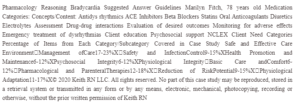Pharmacology Case Study
To have a positive effect on both targeted and non-targeted tissues, a drug must form complexes with its unintended and intended receptors (Kwak et al., 2019). The unintended or intended consequence of a specific level of drug plasma originates from chronic use or the availability of one or more medicines that cause changes in the total number of existing receptors. Furthermore, their ability to respond may result in pharmacological, physiological, and chemical drug interactions that are occasionally used for therapy (Kwak et al., 2019). Examples of pharmacodynamics drug-drug interactions are receptor changes that occur when one drug is chronically administered and reduces the total number of its receptors. It also occurs when the drug alters the adaptability of the receptor (Johansen et al., 2017). Alternatively, when a drug is administered, it chronically increases the total number of receptors or changes the receptor’s adaptability to physiological events.
Another example is pharmacological, where antagonistic drug B and agonistic drug C compete for the same receptor site (Johansen et al., 2017). Depending on their concentrations, drugs B and C may either prevent or cause an effect, or they may interact with various receptors, resulting in the enhancement of actions via various cellular approaches (Kwak et al., 2019). The paper is a case study that seeks to understand the pharmacodynamics of drug interactions.
Patient HM has a history of transient ischemic attack (TIA) and atrial fibrillation, according to the case study. The patient currently has type 2 diabetes, hyperlipidemia, coronary artery disease, and hypertension. Motrin 200mg 1-3 tablets every six hours to help with pain relief and Atenolol 100mg po every day to treat high blood pressure are the medications prescribed. Metformin 1000mg po bid to control blood sugar levels, preventing kidney damage, limb loss, nerve problems, blindness, or sexual dysfunctions. Glyburide 10mg bid to help control sugar levels. Aspirin 81 mg daily is used to treat inflammation and pain while also lowering the risk of blood clots. Warfarin (5mg MWF and 2.5mg T, TH, Sat, Sun) is used to treat blood clots. The medication is a cocktail of ADRs and NSAIDs.
Pharmacodynamic processes begin when drugs reach their target tissues. The effects could be postsynaptic or presynaptic. ADRs are well-known for causing adverse reactions that result in frequent hospitalizations around the world (Norelli et al., 2016). They are among the leading causes of death worldwide. NSAIDs, on the other hand, have effects that are restricted to a subset of users. As a result, long-term and widespread use of the two combinations may pose significant health risks (Kwak et al., 2019). The likelihood of experiencing side effects is related to the patient’s age as well as the dosage (Johansen, 2019). Aging is associated with a high prevalence of multiple chronic conditions, necessitating the use of various therapeutic regimens (Kwak et al., 2019). Aging is marked by changes in drug handling, physiological reserves, and pharmacodynamic responses.
The fundamental pharmacokinetic processes are absorption and excretion, which involve the passage of an orally administered drug from the stomach to the intestines (Norelli et al., 2016). The faster the absorption, the faster the effect on elderly patients, as they experience a decrease in gastric mortality. The passage of drugs from the stomach to the liver is referred to as distribution (Johansen, 2019). Elderly patients have high levels of body fat, which results in a significant drop in drug concentration in the blood (Kwak et al., 2017). As a result, the drug’s effectiveness is reduced. Metabolism entails the oxidation of the drugs, which is greatly influenced by the patients, followed by excretion, which requires the removal of the drugs from the body via the kidneys. Renal functions decline as people age due to a decrease in blood flow. Concealed renal insufficiency also affects the clearance of hydrosoluble drugs. Drug clearance is determined by excretion and metabolism. The changes are caused by pharmacodynamics and pharmacokinetics, polypharmacy, and comorbidity, which puts elderly patients at a higher risk of adverse drug reactions. As a result, there is a massive financial and health burden.
Conclusion
Pharmacodynamic processes occur when drugs are ingested and reach their target tissues. Pharmacokinetic methods, on the other hand, are concerned with drug absorption, metabolism, excretion, and clearance. The two processes are drug interaction processes. There are numerous interactions, including effects that bind receptors. In the case study, HM is taking ADRs and NSAIDs to manage his chronic illness. The effectiveness of the drugs, however, is affected by the patient’s age.
Reference
Kwak, N., Malcolm, M. P., Daley, C. L., Eather, G., Hasegawa, N., Koh, W. J., … & Yim, J. J. (2019). Nontuberculosis mycobacteria infections: would there be pharmacodynamics without pharmacokinetics? European Respiratory Journal, 54(5).
Johansson, S., Rosenbaum, D. P., Knutsson, M., & Leonsson-Zachrisson, M. (2017). A phase 1 study of the safety, tolerability, pharmacodynamics, and pharmacokinetics of tenapanor in healthy Japanese volunteers. Clinical and experimental nephrology, 21(3), 407-416.
Norelli, M., Casucci, M., Bonini, C., & Bondanza, A. (2016). Clinical pharmacology of CAR-T cells: Linking cellular pharmacodynamics to pharmacokinetics and antitumor effects. Biochimica et Biophysica Acta (BBA)-Reviews on Cancer, 1865(1), 90-100.
ORDER A PLAGIARISM-FREE PAPER HERE
We’ll write everything from scratch
Question 
Pharmacology Reasoning Bradycardia Suggested Answer Guidelines Marilyn Fitch, 78 years old Medication Categories: Concepts/Content: Antidys rhythmics ACE Inhibitors Beta Blockers Statins Oral Anticoagulants Diuretics Electrolytes Assessment Drug-drug interactions

Pharmacology Case Study
Evaluation of desired outcomes Monitoring for adverse effects Emergency treatment of dysrhythmias Client education Psychosocial support NCLEX Client Need Categories Percentage of Items from Each Category/Subcategory Covered in Case Study Safe and Effective Care EnvironmentManagement ofCare17-23%XSafety and InfectionControl9-15%XHealth Promotion and Maintenance6-12%XPsychosocial Integrity6-12%XPhysiological IntegrityBasic Care andComfort6-12%Pharmacological and ParenteralTherapies12-18%XReduction of RiskPotential9-15%XPhysiological Adaptation11-17%X© 2020 Keith RN LLC. All rights reserved. No part of this case study may be reproduced, stored in a retrieval system, or transmitted in any form or by any means, electronic, mechanical, photocopying, recording, or otherwise, without the prior written permission of Keith RN